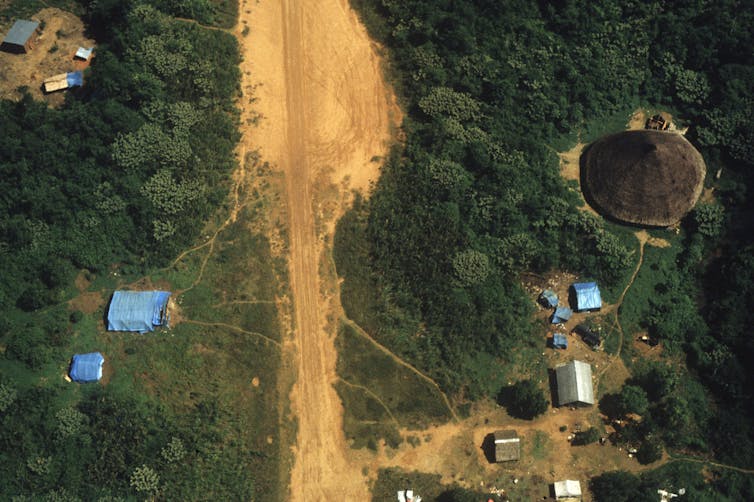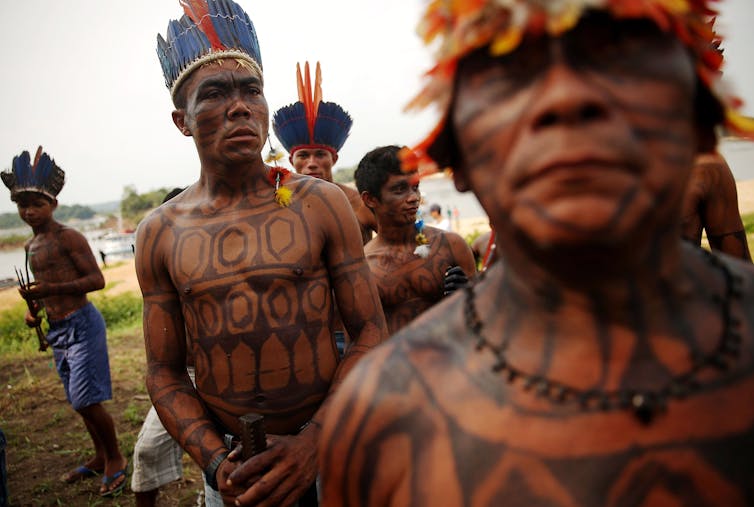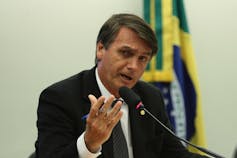Indigenous people may be the Amazon's last hope
- Written by Robert T. Walker, Professor of Latin American Studies and Geography, University of Florida
Brazil’s divisive President Jair Bolsonaro has taken another step in his bold plans to develop the Amazon rainforest.
A bill he is sponsoring, now before Congress[1], would allow transportation infrastructure to be built on indigenous territory. Such lands cover 386,000 square miles of the Brazilian Amazon[2] – one-fifth of the jungle. Here, Native people are constitutionally entitled to exercise sovereignty over resource use.
The right-wing Bolsonaro administration says “opening” the Amazon will boost its economy[3]. But environmentalists, indigenous leaders and other concerned Brazilians[4] say that the move will promote mining, logging and other damaging activities.
As evidence, they cite Bolsonaro’s appointment of a Brazilian general who last year served on the board of the Canadian mining giant Belo Sun[5] to lead Brazil’s federal agency for indigenous peoples.
Our research on social movements in the Amazon[6] takes us to areas affected by infrastructure development. There, we have witnessed the disheartening aftermath for Native people and met the indigenous leaders fighting to save their homelands[7].
Riches now in reach
The Amazon possesses a wealth of minerals including gold, diamonds, iron ore, manganese, copper, zinc and tin[8]. But the region is so remote, with its southern edge lying 1,000 miles from Rio de Janeiro, that resource extraction was long limited by transportation costs[9].
This began to change in the 1970s, when Brazil’s military government built several new highways[10] through the Amazon. It paid little heed to the desires or safety of the 140,000 Native people[11] living there.
Terrible abuses occurred, including the military’s systematic killing from 1967 to 1977 of up to 2,000 Waimiri-Atroari people[12] to make way for a road to the Amazonian capital of Manaus[13].
The territorial aggressions culminated in the 1980s, when up to 40,000 wildcat miners invaded the Yanomami homeland[14] looking for gold. An estimated 20% of the resident indigenous population perished[15] from disease and violence over a seven-year period. Today there are about 900,000 indigenous people in Brazil.
 A gold mining operation set up illegally on Yanomami territory, Jan. 10, 2013, in Roraima state, Brazil.
Ricardo Funari/Brazil Photos/LightRocket via Getty Images[16]
A gold mining operation set up illegally on Yanomami territory, Jan. 10, 2013, in Roraima state, Brazil.
Ricardo Funari/Brazil Photos/LightRocket via Getty Images[16]
After democracy was restored in 1985, Brazil got a new constitution[17] that codified indigenous rights, including the right to aboriginal homelands. Because so much of the Amazon[18] is indigenous territory, indigenous sovereignty became instrumental to Brazilian environmental policy[19].
The connection between indigenous communities and conservation is global. Indigenous people make up 5% of the world’s population, but their homelands hold 85% of its biodiversity[20]. This can make indigenous people extremely effective environmental defenders, because in fighting for their ancestral territory they protect some of the world’s most pristine places[21].
 Munduruku people gather along the Tapajós River to protest a proposed dam on Nov. 27, 2014, in Pará, Brazil.
Mario Tama/Getty Images[22]
Munduruku people gather along the Tapajós River to protest a proposed dam on Nov. 27, 2014, in Pará, Brazil.
Mario Tama/Getty Images[22]
A world in peril
At the turn of the millennium, Brazil was generally considered a good steward of the Amazon[23].
About a decade into the 21st century, however, environmental policy began to weaken[24] to allow more infrastructure development[25] in the Amazon. By 2016, some 34,000 square miles of the Brazilian Amazon had lost its previously protected status or seen protections reduced[26].
Indigenous sovereignty, however, was never called into question – until now. Since taking office in January 2019, Bolsonaro has also cut funds for the enforcement of Brazil’s strict environmental laws[27], leading Amazon deforestation to spike[28].
 Brazilian President Jair Bolsonaro.
Fabio Rodrigues Pozzebom/Agência Brasil/Wikimedia, CC BY-SA[29][30]
Brazilian President Jair Bolsonaro.
Fabio Rodrigues Pozzebom/Agência Brasil/Wikimedia, CC BY-SA[29][30]
Brazil’s president has long seen protected indigenous land as a treasure trove of resources[31]. In 2015 then-Congressman Bolsonaro told the newspaper Campo Grande News[32] that “gold, tin and magnesium are in these lands, especially in the Amazon, the richest area in the world.”
“I’m not getting into this nonsense of defending land for the Indians,” he added.
Bolsonaro defends his current efforts to build in the Amazon as a means of assimilating native Brazilians so they will no longer need their territorial homelands.
“The Indian has changed, he is evolving and becoming more and more a human being like us. What we want is to integrate him into society,” he said in a video posted to social media in January[33].
The statement prompted a lawsuit by indigenous Brazilians[34] accusing the president of racism, a crime in Brazil.
Resistance as conservation
Accelerating deforestation under Bolsonaro has sparked violence in the Amazon.
Seven indigenous land activists were killed in 2019[35], according to the Brazilian not-for-profit Pastoral Land Commission, the most in over a decade. Indigenous environmental leaders in the Colombian[36] and Ecuadorian[37] Amazon have also been murdered.
Such killings mostly go unsolved. But Brazil’s Indigenous Peoples Association says one indigenous activist killed in 2019, Paulo Guajajara, was gunned down by illegal loggers in November for defending Guajajara territory[38] as part of an armed group called Guardians of the Forest.
“We are protecting our land and the life on it,” Guajajara told Reuters[39] shortly before his murder. “We have to preserve this life for our children’s future.”
 Paulo Guajajara, a Guardian of the Forest who was killed in November 2019, seen here in 2015 at age 22.
Bonnie Jo Mount/The Washington Post via Getty Images[40]
Paulo Guajajara, a Guardian of the Forest who was killed in November 2019, seen here in 2015 at age 22.
Bonnie Jo Mount/The Washington Post via Getty Images[40]
Indigenous Brazilians have also defended their land in court.
In 2012, the Munduruku sued to stop the construction of mega-dams and waterways[41] in the Tapajós River Valley – projects that would have ended life as they know it. Federal prosecutors agreed, filing in support of the Munduruku and calling for the suspension of the largest dam’s environmental license.
Under legal pressure, the Brazilian Institute of the Environment and Renewable Natural Resources in their April 2016 decision[42] curtailed the entire infrastructure plan, conserving 7% of the Amazon Basin[43].
Amazon’s last hope
Not every indigenous Brazilian is a born environmentalist. Many mix traditional livelihoods like hunting, fishing and gathering with agriculture and ranching[44].
Like other farmers who clear forest to plant more crops[45], indigenous farmers stand to benefit from Bolsonaro’s environmental deregulation. The president recently announced his administration would offer credit to indigenous soybean farmers who want to expand their operations[46].
In Roraima state, the Raposa Serra do Sol people[47] live on land rich with gold, diamonds, copper and a slew of lesser-known metals that Bolsonaro regards as strategic to Brazil’s metallurgical economy[48]. Royalty payments to Native peoples who open their land to miners could be substantial.
So far, however, indigenous groups are united in their resistance to federal and corporate[49] interference. They may be the Brazilian Amazon’s last hope.
[Get the best of The Conversation, every weekend. Sign up for our weekly newsletter[50].]
References
- ^ now before Congress (www25.senado.leg.br)
- ^ Brazilian Amazon (pib.socioambiental.org)
- ^ boost its economy (www.acritica.com)
- ^ environmentalists, indigenous leaders and other concerned Brazilians (amazonialatitude.com)
- ^ Canadian mining giant Belo Sun (www.reuters.com)
- ^ research on social movements in the Amazon (scholar.google.com)
- ^ indigenous leaders fighting to save their homelands (www.internationalrivers.org)
- ^ gold, diamonds, iron ore, manganese, copper, zinc and tin (www.cell.com)
- ^ long limited by transportation costs (www.tandfonline.com)
- ^ built several new highways (onlinelibrary.wiley.com)
- ^ 140,000 Native people (www.precog.com.br)
- ^ Waimiri-Atroari people (apnews.com)
- ^ a road to the Amazonian capital of Manaus (lab.org.uk)
- ^ up to 40,000 wildcat miners invaded the Yanomami homeland (pib.socioambiental.org)
- ^ 20% of the resident indigenous population perished (www.survivalinternational.org)
- ^ Ricardo Funari/Brazil Photos/LightRocket via Getty Images (www.gettyimages.com)
- ^ new constitution (www.planalto.gov.br)
- ^ so much of the Amazon (www.tandfonline.com)
- ^ instrumental to Brazilian environmental policy (www.pnas.org)
- ^ 5% of the world’s population, but their homelands hold 85% of its biodiversity (www.nationalgeographic.com)
- ^ protect some of the world’s most pristine places (www.goldmanprize.org)
- ^ Mario Tama/Getty Images (www.gettyimages.com)
- ^ considered a good steward of the Amazon (www.pnas.org)
- ^ began to weaken (conbio.onlinelibrary.wiley.com)
- ^ more infrastructure development (www.nature.com)
- ^ lost its previously protected status or seen protections reduced (www.sciencedirect.com)
- ^ cut funds for the enforcement of Brazil’s strict environmental laws (news.mongabay.com)
- ^ deforestation to spike (theconversation.com)
- ^ Fabio Rodrigues Pozzebom/Agência Brasil/Wikimedia (upload.wikimedia.org)
- ^ CC BY-SA (creativecommons.org)
- ^ treasure trove of resources (www.cell.com)
- ^ told the newspaper Campo Grande News (www.campograndenews.com.br)
- ^ said in a video posted to social media in January (www.reuters.com)
- ^ prompted a lawsuit by indigenous Brazilians (www.reuters.com)
- ^ were killed in 2019 (g1.globo.com)
- ^ Colombian (sostenibilidad.semana.com)
- ^ Ecuadorian (es.mongabay.com)
- ^ defending Guajajara territory (www.theguardian.com)
- ^ Reuters (fr.reuters.com)
- ^ Bonnie Jo Mount/The Washington Post via Getty Images (www.gettyimages.com)
- ^ stop the construction of mega-dams and waterways (www.theguardian.com)
- ^ April 2016 decision (news.mongabay.com)
- ^ 7% of the Amazon Basin (www.cell.com)
- ^ agriculture and ranching (pib.socioambiental.org)
- ^ farmers who clear forest to plant more crops (theconversation.com)
- ^ credit to indigenous soybean farmers who want to expand their operations (www.reuters.com)
- ^ Raposa Serra do Sol people (www.theguardian.com)
- ^ Bolsonaro regards as strategic to Brazil’s metallurgical economy (www.reuters.com)
- ^ groups are united in their resistance to federal and corporate (www.ecosystemmarketplace.com)
- ^ Sign up for our weekly newsletter (theconversation.com)
Authors: Robert T. Walker, Professor of Latin American Studies and Geography, University of Florida
Read more https://theconversation.com/indigenous-people-may-be-the-amazons-last-hope-130941


